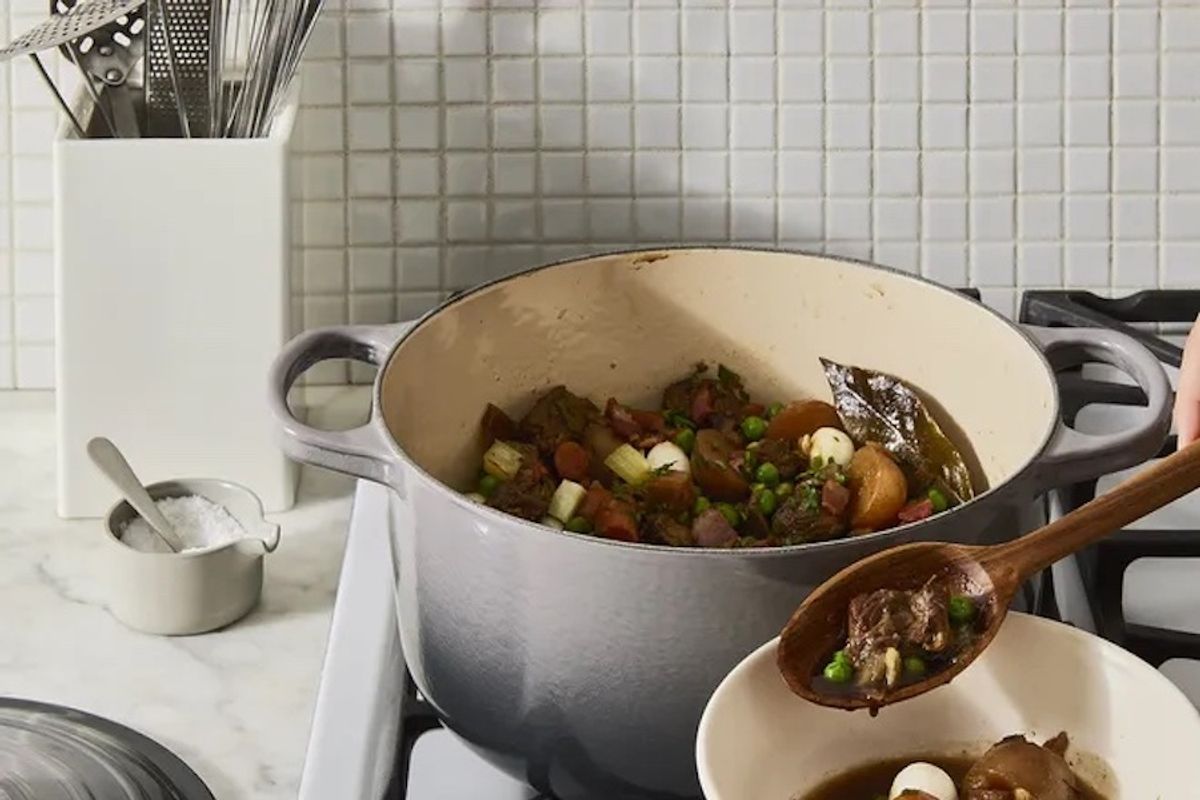Everything you need to know about Dutch oven cooking

The Dutch oven—or as I like to call it, the analog crock pot—is a favorite among those who love cooking. The hype around Dutch ovens exists for good reason: They are highly effective, beautiful, dynamic, and durable pieces of cookware. Many of the dishes central to your core cold-weather food memories likely came from a Dutch oven, as it is the ideal vessel for braised short ribs, seafood stew, sourdough bread, and countless other cozy classics.
As someone who also loves to cook, allow me to stay true to form—here is everything you need to know about Dutch oven cooking.
What is a Dutch oven?
A Dutch oven is a heavy, thick-walled pot with a tight-fitting lid. Typically made of enameled cast iron or stainless steel, dutch ovens heat quickly and maintain temperature effectively, making it an ideal vessel for searing and browning. Meanwhile, the tight-fitting lid traps moisture within the pot, enabling Dutch ovens to cook braises and stews evenly over several hours. Suitable for ovens and stovetops, the Dutch oven is capable, durable, and flexible to your cooking needs.
Cooking techniques for Dutch ovens:
A Dutch oven gets hot and stays hot, meaning it can accommodate a wide range of cooking techniques. Of these techniques, the most common are braising, stewing, browning, frying, and baking.
Braising
Our dear friend Sohla El-Waylly puts it best: “Braises involve hefty burly chunks of meat or vegetable, like a bone-in lamb leg or head of cauliflower, which are only partially submerged in liquid. The braising liquid creates steam and provides moisture, breaking down tough connective tissue and tenderizing dense vegetables. At the same time, the half that’s uncovered can go to brown town.”
Browning
The expedited route to “brown town” begins with cranking up the temperature underneath your Dutch oven and using high heat to create a crust on the outside of meat or vegetables. In many recipes, browning often precedes braising which is why I’ve long-lived by the very apt motto: “but first, browning.”
Frying
Fill your dutch oven no more than halfway with oil and then heat to your recipe’s prescribed temperature. Submerge your ingredients in the heated oil until cooked, then rest them on a paper towel or wire rack to remove excess oil. Always remember: Frying can be unforgiving, especially at home—so please consult our guide if you’re new to the home-frying game.
Baking
When I say, “bake,” you say, “bread!” When I say, “baked,” you say, “beans!” It’s a tricky chant, but after five summers of Dutch Oven Baking Camp I finally got it down. You’ll pick it up faster. Either way, the point remains—Dutch ovens bake bread, beans, and whatever else your heart desires. Noteworthy: If you’d like to incorporate steam in your baking process (if you’re making bread, for example), keep your Dutch oven closed.
Stewing
Instead of letting your meat and vegetables frolic in the braising kiddy pool, fully submerge them in the stewing deep end to achieve rapid flavor maturation. Often capable of holding at least five quarts of liquid, a dutch oven is the perfect pot for a big batch of stew. Best practices: When stewing, make sure to maintain a consistent size for each ingredient so that every pea, carrot, and hunk of beef will cook evenly.
Best Dutch ovens
Are you living life sans Dutch oven? Did your ex claim it when you moved out? Are you due for a Dutch oven upgrade? Whatever the circumstance, we have the Dutch oven for you. Here are our three favorites right now.
Staub Enameled Cast Iron Dutch Oven
Dishware safe, heat resistant up to 500 degrees, and textured for improved browning, this cast iron Dutch oven from Staub is durable, beautiful, and high-performing.
Lodge Enameled Cast Iron Dutch Oven
A perfectly functional dutch oven that doesn’t incinerate your savings. If you’re new to Dutch-oven cooking, this enameled cast iron model from Lodge is a great place to start.
Le Creuset 5.5-Quart Dutch Oven
Timeless, elegant, and fully capable of withstanding generations of use (I still use my grandmother’s), this Le Creuset is an investment, not a purchase.

